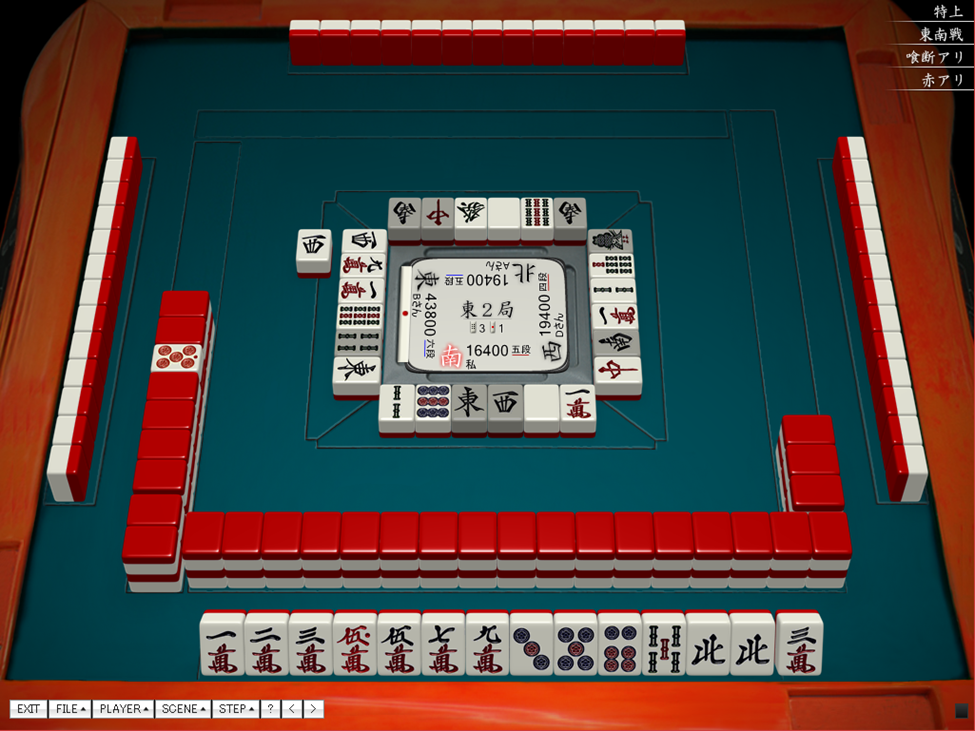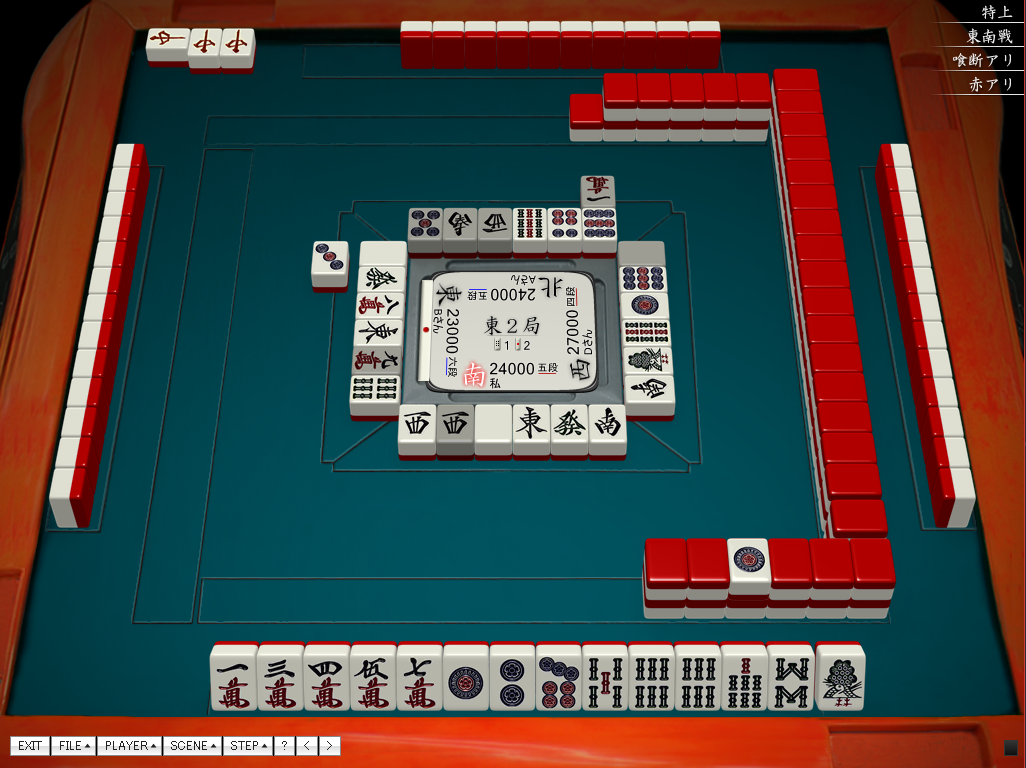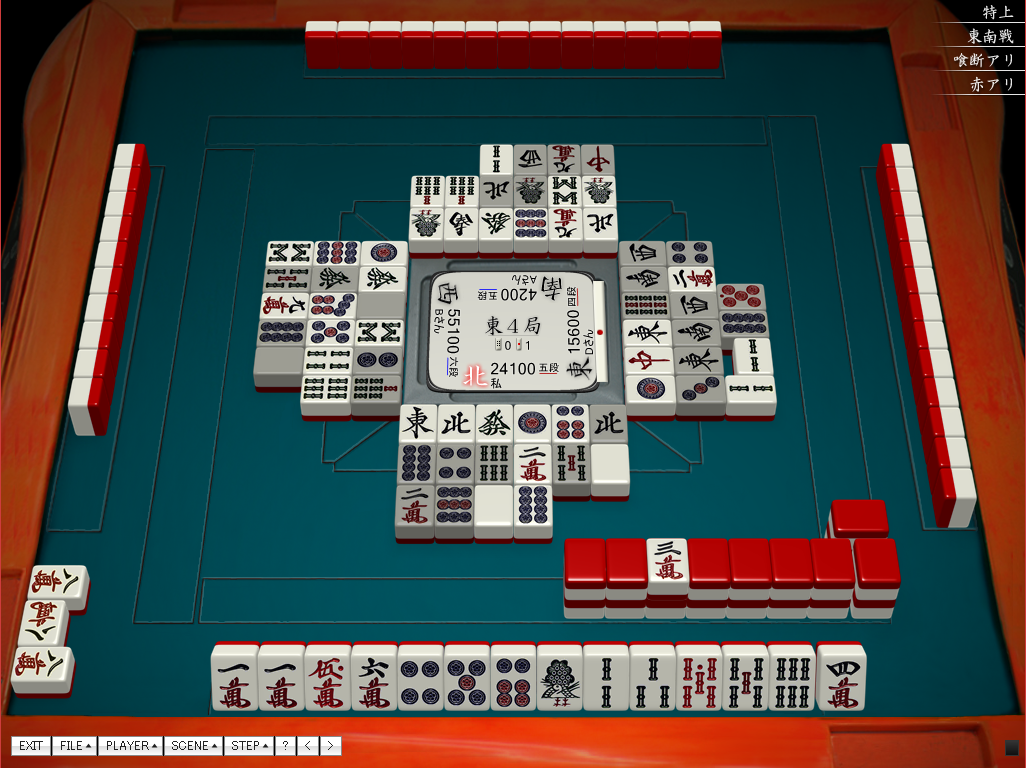Mahjong Fundamentals 7: When to Defend
Deciding when to push in riichi mahjong is a very delicate balance to try and find. A player who rarely defends will usually not have a very good win-rate, at least against experienced players, but at the same time a player who always folds at the first sign of danger will typically struggle as well. Push/fold judgement is incredibly tricky and typically very situational, and is something that even very high level players will commonly disagree on in specific scenarios.
That said, a key thing to learn as a new player is when you should fold, and there are still many situations where the push/fold judgement is relatively clear-cut and there is an agreed ‘correct’ answer amongst most high-level players.
When to consider folding
For the most part you can completely ignore defence against your opponents except for two situations:
- A player has declared riichi
- A player has an open hand that is confirmed mangan or better, especially if they have called more than once
This is because it is incredibly difficult to read whether a fully closed hand is tenpai without having declared riichi, and because dealing into inexpensive open hands is usually not a huge problem. If you’re playing in a game where nobody has declared riichi or made any calls, then it’s safe to focus on your own hand and not worry too much about what your opponents are doing. Obviously sometimes players will be in tenpai and won’t have declared riichi, or will have yakuhai and a hidden dora 3, but it is not a good strategy to break up otherwise good hands on guessing that these might be the case.
One exception is for players who are almost certainly pursuing a flush hand (i.e. honitsu or chinitsu) and have begun discarding tiles from the suit they appear to be collecting. This usually indicates that they are tenpai and it’s worthwhile trying to play around their hand.
Situations to fold
So, you’re halfway through a hand and the player opposite you declares riichi. Do you fold, or do you push and try and win? The answer depends on your hand.
In general, you should fold if:
- You are tenpai but your score is below 7700 and your wait is bad
- You are 1-shanten and your expected hand value would be below 7700 or you don’t have a guaranteed good wait
- You are 2-shanten or higher
In these situations we should fold if advancing our hand would require us to discard a tile that is not safe. Obviously if we can continue to push our hand whilst discarding 100% safe tiles (genbutsu) then it is OK to do so.
As was discussed in the last article, mahjong is a game where you won’t be the winning player the majority of the time. It’s important to recognise this when faced with situations where folding is the right choice, and not to be too aggressive and try to win hands when the odds are stacked against you and you have good defensive options.
Situations to push
So what about when someone declares riichi and we have a good hand? If the hand is good enough, then it’s worth pushing.
In general, you should push if:
- You are in tenpai and your minimum value is above 3900 points with a good wait
- You are in tenpai and your minimum value is above 7700 points with a bad wait
- You are 1-shanten and your worst hand development guarantees you 7700 points and a good wait
Typically any wait that is five or more possible tiles is considered a good wait, and any wait on four or fewer tiles is a bad wait. When chasing against someone else in tenpai, the wait is very important as once you push the game effectively becomes a tile-flipping contest for whose winning tile appears first. In these cases a ryanmen wait gives you double the chance of winning (8 tiles) over a penchan or kanchan wait (4 tiles).
It should be noted that these situations are quite rare. Typically if you are already in tenpai you will have declared riichi, and therefore cannot decide to fold anyway, and hands that are 1-shanten or higher with both good wait and mangan guaranteed are not that common.
The Grey Area
The principles lined out above are general rules of thumb for steering your decision in push-fold on the assumption that all 100% safe tiles you could discard would involve breaking up your hand, and any tile you need to discard to progress the hand is likely to deal in. Often in mahjong this is not the case, and we can advance our hand by playing tiles which are not 100% safe but are partially safe (through techniques like suji or kabe as discussed in the previous article). This, however, is something of a dark art, and is much too complex to lay out in a single article, let alone one aimed at covering fundamentals!
In general, bear in mind the three fundamental aspects of your hand, which in order of importance are: your shanten, your value, and the quality of your waits. If all three are bad, then definitely fold (and fold by discarding the safest tiles you can). Likewise if all three are good, then push pretty much any tile you need to. If you have one or two out of three, then it really depends on how risky the tile you need to push is. But don’t be afraid to fold good hands, and in particular don’t focus so much on what your hand could be that you ignore what it currently is. If you have a potential haneman at 3-shanten you should still play defensively a lot of the time, because the chance you’ll reach tenpai without dealing in is very low.
It’s also worth being aware of the points situation, particularly in later rounds. If you are far behind in South round you should typically be more inclined to push, particularly if your hand has high value. Vice-versa, if you are leading in the later rounds of the game you should be more inclined to fold if someone reaches tenpai before you.
Examples
Here are five example hands, for each one consider whether you want to push or fold this hand, and which tile would be best to discard:
1)

There is a dealer riichi to our left. Our hand has two dora and so good value potential, however we are still far from tenpai and so it would be wise to fold here. We should discard  or
or  , as they are the only 100% safe tile in our hand.
, as they are the only 100% safe tile in our hand.
2)

In this case there is a riichi to our left. Our hand is 2-shanten, with low chance of becoming mangan and a couple of awkward shapes to be completed. We should fold here by discarding  , as it is our only safe tile.
, as it is our only safe tile.
3)

Here we have a late dealer riichi to our right. We have just reached tenpai, and through discarding  we can be tenpai for a hand that is at worst a pinfu dora 3 mangan, and potentially a haneman if we win on
we can be tenpai for a hand that is at worst a pinfu dora 3 mangan, and potentially a haneman if we win on  . It is worth noting that we do not have a particularly good wait, as three of the
. It is worth noting that we do not have a particularly good wait, as three of the  tiles and one
tiles and one  tile have already be discarded. However the value here is enough that it is OK to push
tile have already be discarded. However the value here is enough that it is OK to push  .
.
It also helps that  is covered by suji from a
is covered by suji from a 
 wait, and is double one-chance from a
wait, and is double one-chance from a 
 wait (you can see three
wait (you can see three  and three
and three  ), and therefore despite being a middle discard,
), and therefore despite being a middle discard,  is relatively safe to push out.
is relatively safe to push out.
As a side note, you should not riichi here on the  as your hand already has sufficient value without it.
as your hand already has sufficient value without it.
Push/fold decision-making is a difficult aspect of riichi mahjong to master, and this article provides only a basic introduction to the topic. There are a lot of factors at play when choosing whether to defend or push, and two situations are rarely the same. For more detailed discussion on defence, please read Chapter 8 of Riichi Book 1, as well as this article series by Puyo. Also bear in mind that hindsight bias can be very strong with push/fold – just because a tile would have passed does not mean folding was necessarily the wrong choice with the information you had at the time.
In the next article, we’ll switch back to looking at tile efficiency in a bit more depth, and will look at some of the more common complex shapes that you’ll encounter in mahjong, along with how to identify when neighbouring tiles help or hinder each other.
In the last one, shouldn’t one riichi since ippatsu is guaranteed?
And even if it wasn’t near the end of the round, isn’t riichi still strictly better since you can’t expect the defending two to discard the unsafe 47s whether you dama or not?
Ippatsu is never guaranteed. Since there’s only one turn left, chances are you’d just be throwing away 1000 points for no reason.
As for your second question, assuming it’s earlier in the round and the scores are flat, a chase riichi can certainly be a valid option, but in the interests of clarity and accuracy let’s break this down into a few scenarios.
If you’re the first to tenpai, you should typically stay dama. Pinfu with three dora and potential sanshoku is high enough value that you don’t want to lower your chance of winning by declaring riichi.
If someone has declared riichi before you, the other players are defending, and you’re waiting on a tile that’s safe against the riichi, then dama is the right choice, as the other players may deal in as they try to defend.
If, as in the screenshot above, you’re waiting on a tile that’s dangerous against the other riichi, then declaring riichi usually won’t hurt your chances of winning by all that much. The player in riichi can’t defend, and as you say, the two defending players already aren’t likely to deal in. However, though riichi becomes a valid option, it won’t necessarily always be the correct option. There are lots of other situational factors to consider.
First and foremost is the strength of your wait. If you declare riichi, the game is reduced to a luck-based tile-flipping contest, where the winner will be whoever happens to have their winning tile in the wall first. If you’re going down this route, you’d better hope you’ve got more winning tiles in the wall than the other guy. In this example, despite having a ryanmen, there are only four 47s remaining, and you don’t know whether they’re in the live wall, the dead wall, or other players’ hands.
Additionally, if an opponent declares riichi late in the round, you should expect them to have a good wait, so this further affects your chances of winning any riichi duel. Advanced techniques such as wall-reading and hand-reading can come into play here, but these can often backfire.
It’s also important to realise that, in this example, the player in riichi is the dealer, so dealing into them will hurt 1.5 times more than usual. This affects your risk/reward calculations.
You should also consider the score situation. In this example, you’re a long way behind first, so even if you declare riichi, winning this hand won’t actually improve your placing. At best, you’ll just be a bit more secure in second place. Since the potential reward is low, you should limit the amount of risk you expose yourself to.
To summarise, chase riichi can certainly be an option, but it’s very conditional. If in doubt, it’s better to just play it safe.
1
Thanks for the article!
Example 1 – 9m is also genbutsu. Discarding 9m first seems better because 1m will be safe for two players in case Shimocha attacks.
Fixed – thanks for pointing out the mistake!
the link to riichi book 1 on this article is now leading to a malware site
Fixed, thanks
1
q6TVibmY
if(now()=sysdate(),sleep(15),0)
-1; waitfor delay ‘0:0:15’ —
-5 OR 778=(SELECT 778 FROM PG_SLEEP(15))–
2Ky0XxzF’) OR 251=(SELECT 251 FROM PG_SLEEP(15))–
1’||DBMS_PIPE.RECEIVE_MESSAGE(CHR(98)||CHR(98)||CHR(98),15)||’
1
1
1
1
1
10’XOR(1*if(now()=sysdate(),sleep(15),0))XOR’Z
14za3bE6D’ OR 296=(SELECT 296 FROM PG_SLEEP(15))–
1%2527%2522\’\”
1
1
1